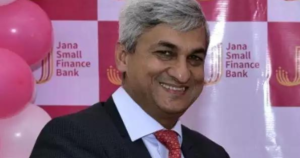- Jana Small Finance Bank improved asset quality via strategic shifts.
- Notable decrease in NPA ratio from 7.2% (FY21) to 3.9% (FY23).
- Ajay Kanwal’s leadership pivotal in the bank’s turnaround.
- Emphasis on secured lending and digitization for sustainable growth.
- National presence with 24 states, 771 branches, and 49 lakh customers.
- Net interest margins (NIMs) sustained at 7.8% (September).
- Proactive measures to address NPA concerns during COVID-19.
- Resolution of debt issues in holding companies ensures financial stability.
Jana Small Finance Bank Improving Asset Quality: A Change in Strategy :
Jana Small Finance Bank’s asset quality has improved significantly, thanks to a strategy change towards secured lending, according to Ajay Kanwal, the bank’s Managing Director and CEO. This strategic shift has resulted in considerable improvements in the bank’s asset quality indicators, addressing concerns that had previously classified Jana Small Finance Bank as a laggard in its industry.
Reversal of Fortunes :
For a long time, Jana Small Finance Bank suffered with asset quality difficulties, drawing unfavourable comparisons to competitors such as AU Small Finance Bank, Equitas, Ujjivan, and Bandhan Bank. However, under Ajay Kanwal’s leadership, the bank has implemented actions that have resulted in a turnaround and clean-up of its financial accounts.
Notable Improvements :
The bank’s non-performing asset (NPA) ratio fell sharply from 7.2 percent in FY21 to 3.9 percent in FY23, indicating a significant improvement in its financial health. In an interview with Moneycontrol, Kanwal emphasised the influence of COVID-19 on asset quality while noting the issues it presents, particularly in the intermediate to lower sectors. Despite the challenges, the bank maintained profitability throughout the epidemic, demonstrating its resilience and smart financial management.
Strategic initiatives :
Kanwal discussed two key areas of the bank’s transformation: financial performance and digitization. The bank has moved its attention to secured lending products such as mortgages, loans against property, and two-wheelers, a departure from its microfinance roots. Additionally, Jana Small Finance Bank has embraced digitization, establishing itself as a forward-thinking institution capable of operating efficiency and scalability.
National Presence :
Jana Small Finance Bank has a countrywide base that spans 24 states, 771 locations, and serves 49 lakh consumers, allowing for organic growth and market expansion.
Sustainable Growth and Financial Health :
Net Interest Margin (NIM) and Outlook :
Jana Small Finance Bank retains a competitive advantage with net interest margins (NIMs) of 7.8 percent as of September, displaying consistency and endurance in a challenging market situation. Kanwal forecasts long-term growth, highlighting the bank’s progressive shift towards secured lending and its implications for NIMs and asset quality.
Addressing NPA Concerns :
Despite historical problems, the bank has made significant progress in mitigating NPAs, as evidenced by a reduction in gross NPAs from 7% to 2.4% for the six months ending September 30, 2023. Kanwal blames the increase in NPAs during the pandemic to socioeconomic upheavals, but he praises the bank’s prudent provisioning and profitability despite difficulty.
Resolution of Holding Company Debt Concerns:

Financial stability:
Addressing concerns about Jana Holdings and Jana Capital, Kanwal assures stakeholders that all debt-related difficulties inside the holding company structure are resolved. With the next loan deadline not until May 2026, the bank is on firm ground, demonstrating its commitment to financial prudence and transparency.
Conclusion :
Jana Small Finance Bank’s journey demonstrates resilience, adaptability, and strategic foresight in overcoming hurdles and creating long-term success. Through a concerted focus on asset quality, digitization, and financial stability, the bank has emerged as a powerful participant in the competitive environment of small financing institutions.

